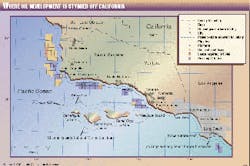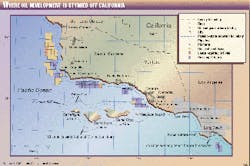Drilling off California hits new roadblocks
Owners of 40 leases off central California are being stymied yet again in their attempts to develop viable plans for tracts that the US Minerals Management Service estimates hold more than 1 billion bbl of oil and 500 bcf of gas.
The oil industry paid $1.25 billion for the leases during 1968-1984, plus annual lease rentals. Although low oil prices and internal corporate priorities prevented more-immediate plans, so, too, has an anti-oil movement in California that was most recently solidified by the administration of Gov. Gray Davis, the California Coastal Commission (CCC), and a block of politicians representing the areas most directly affected by lease development.
Cancellations sought
In June, California legislators asked the administration of President Bill Clinton to terminate the 40 leases on the Outer Continental Shelf along San Luis Obispo, Santa Barbara, and Ventura counties. Those leases were always thought to be relatively safe from federal moratoriums and an ever-accelerating drive to expand marine sanctuaries. Not any more.
Two days after CCC threatened a lawsuit against the US Department of the Interior for more review authority, Interior Sec. Bruce Babbitt on Aug. 13 canceled 4 of the 40 leases, citing "regulatory deficiencies." Oil company representatives say the "deficiencies" are a disagreement over whether there is enough oil under those leases.
Three of the canceled leases are operated by Aera Energy Inc., Bakersfield, Calif., and the fourth by Samedan Oil Corp., a unit of Noble Affiliates Inc., Ardmore, Okla.; they are OCS PO 462, 420, 424, and 429. "We wouldn't keep paying to keep them if we didn't believe they have potential," said Sam- edan's Ron Heck, coordinator of its Gato Canyon unit and a geologist. The industry should at least be given the opportunity to conduct exploratory drilling, he maintains.
"This is such a highly complex issue we are reluctant to make any commentellipseWe're still in the process of evaluating our options," said Susan Hersberger, speaking for Aera Energy. However, she added, "ellipseThe perspective we take is (that) it's premature to make policy decisions until specific projects are proposed."
MMS followed up Babbitt's dispatch by extending the deadline-to Nov. 15-for oil companies to revise general plans and schedules, and the commission put its plans for a lawsuit on hold.
State claims authority
Hot on the heels of that action, the California State Lands Commission (SLC) on Sept. 3 voided three leases within the state's 3-mile limit for inclusion in a marine sanctuary.
The difference between the federal and state actions is that the three state leases were quit-claimed by the owners: Texaco E&P Inc. and Production Line Inc. holding two, and Exxon Corp. and BP Amoco PLC the third. Venoco Inc., Santa Barbara, declined to quit-claim a similar lease. Still, SLC Chairman and state Lt. Gov. Cruz Bustamante declared,"ellipseThe action represents an important turning point in environmental policy."
A follow-up comment by state Director of Finance Tim Gage "calls on the federal government to follow the state's lead in terminating previously undeveloped leases." Given the source, it appears the state isn't agonizing over potential lost income from oil and gas development.
CCC seeks new authority to review plans for developing leases on the federal OCS-and under stricter guidelines. The MMS delay was in deference to CCC's request for more information, and Babbitt said the postponement was "to provide a fuller record on the question of whether the passage of time, combined with changed circumstanceellipsemay require the submittal of new plans, rather than the simple updating or revision of previously approved plans."
After the OCS leases were first issued, the US Supreme Court in the 1980s ruled that CCC did not have jurisdiction over the tracts, but congressional changes in 1990 allowed increased state review.
"Clearly, we're under attack," said Frank Holmes, spokesman for the Western States Petroleum Association. "The MMS is treating this differently than any other place in the nation, and it's inappropriate."
In contrast, the latest developments are cheered by environmentalist lobby groups that are banding together to urge a permanent ban on any new oil development-and supporting extension of marine sanctuaries. "Four down and 36 to go," commented Pat Veesart of the Environmental Center of San Luis Obispo County, a phrase that was repeated in a local newspaper headline.
Ending offshore oil development was a key campaign issue for Davis and congressional and state legislative candidates representing the oil-rich areas off California's coast, all of whom won in November 1998. The results of those victories are now converging on the oil industry.
Information sought
The "additional information" sought by Babbitt and originating from the state CCC, asks leaseholders to explain how their plans will address: impacts on sea otters and other marine life, the Monterey Bay National Marine Sanctuary (established in 1995 after the tracts were leased), new air and water quality standards, and changes in drilling technology-as well as a profusion of new oil companies.
"Most of those things have already been addressed," Holmes countered, and any holes "would be readdressed through any environmental assessment."
Perhaps most troubling to the oil industry is that the latest roadblocks are being erected just when an often-delayed 6-year study was released in final draft form in early October (OGJ, June 22, 1998, p. 32). Comments on the study will be received through Nov. 15 to MMS's Pacific Region.
Known by its acronym COOGER (California Offshore Oil & Gas Energy Resources), the study "is designed to provide information on the limitations that onshore conditions and infrastructure may pose to the potential development of offshore oil and gas resources," including the 40 (now 36) OCS and 23 state tracts under lease. It also describes a range of development scenarios but is not intended to be a "decision document" nor an "environmental analysis."
The impetus for COOGER was repeated requests to the MMS from counties, cities, local politicians, and environmental groups to assess the "big picture" before going ahead with more oil projects (OGJ, Nov. 20, 1995, p. 33). The oil industry "agreed to this voluntary time-out," Holmes said, hoping the study would help avoid the bitter battles that occurred in permitting the Chevron Point Arguello and Exxon Santa Ynez Unit projects-especially the onshore processing plants-among others.
Preliminary plans
Oil company plans submitted to the MMS and outlined in "scenarios" in the COOGER report range from no new development to producing 160,000 b/d of oil from the offshore Santa Maria basin by 2010 and processing it onshore in Santa Barbara's North County area.
Up to four new offshore platforms could be installed, primarily in the Santa Maria basin north of existing Santa Barbara Channel units; in addition, new reserves could be developed via extended-reach drilling from existing OCS platforms or from onshore sites into state waters. Indeed, Exxon Corp. is already drilling a development well into its Sacate field from Platform Heritage, deciding to tap into those reserves in its Santa Ynez Unit via extended-reach drilling, rather than by adding a fourth platform in the unit.
Although there may be four new platforms proposed, another six to eight OCS platforms are expected to be removed, according to the MMS, leading to "a net reduction in the number of platforms offshore California." Furthermore, the 36 undeveloped leases are consolidated into nine units "and may be further consolidated into 6 or 7 unitsellipseallowing more-efficient exploration, development, and production," said John Romero, public information officer for the MMS's Pacific Region.
The operating companies involved in submitting general plans include Aera, Samedan, Venoco, Nuevo Energy Co., Conoco Inc., and Whiting Petroleum Corp. Most want to conduct further seismic surveys, analyze 3D seismic data, and drill exploratory and delineation wells. Plans by Whiting, Venoco, and Conoco envision tapping into leases from existing platforms from the Point Arguello Unit, while Aera's plans to develop its Santa Maria basin leases would entail new platforms.
If all the proposed plans are put into effect, the MMS said "production could remain stable," but "the presence of the oil industry will likely appear to diminish."

